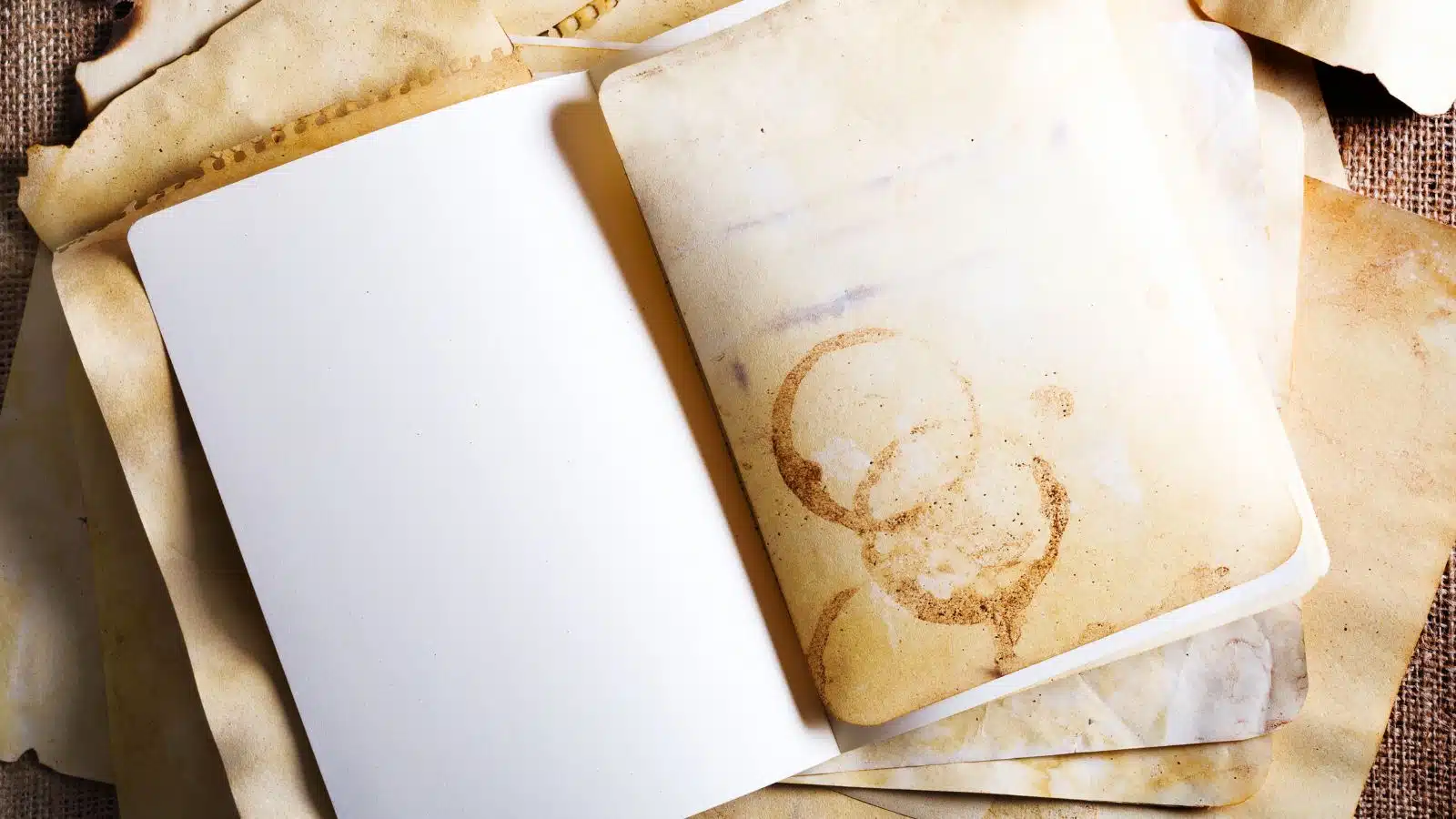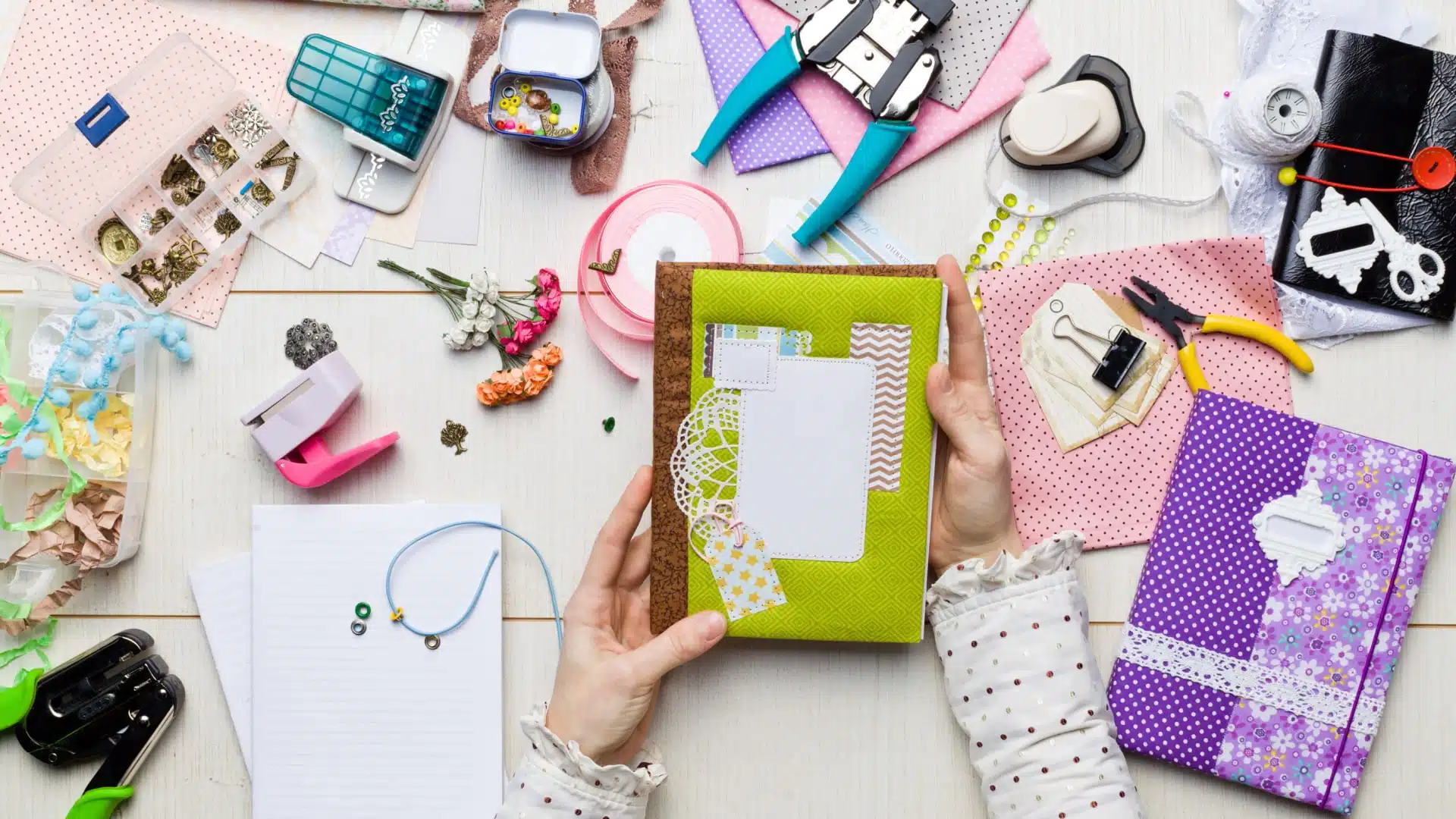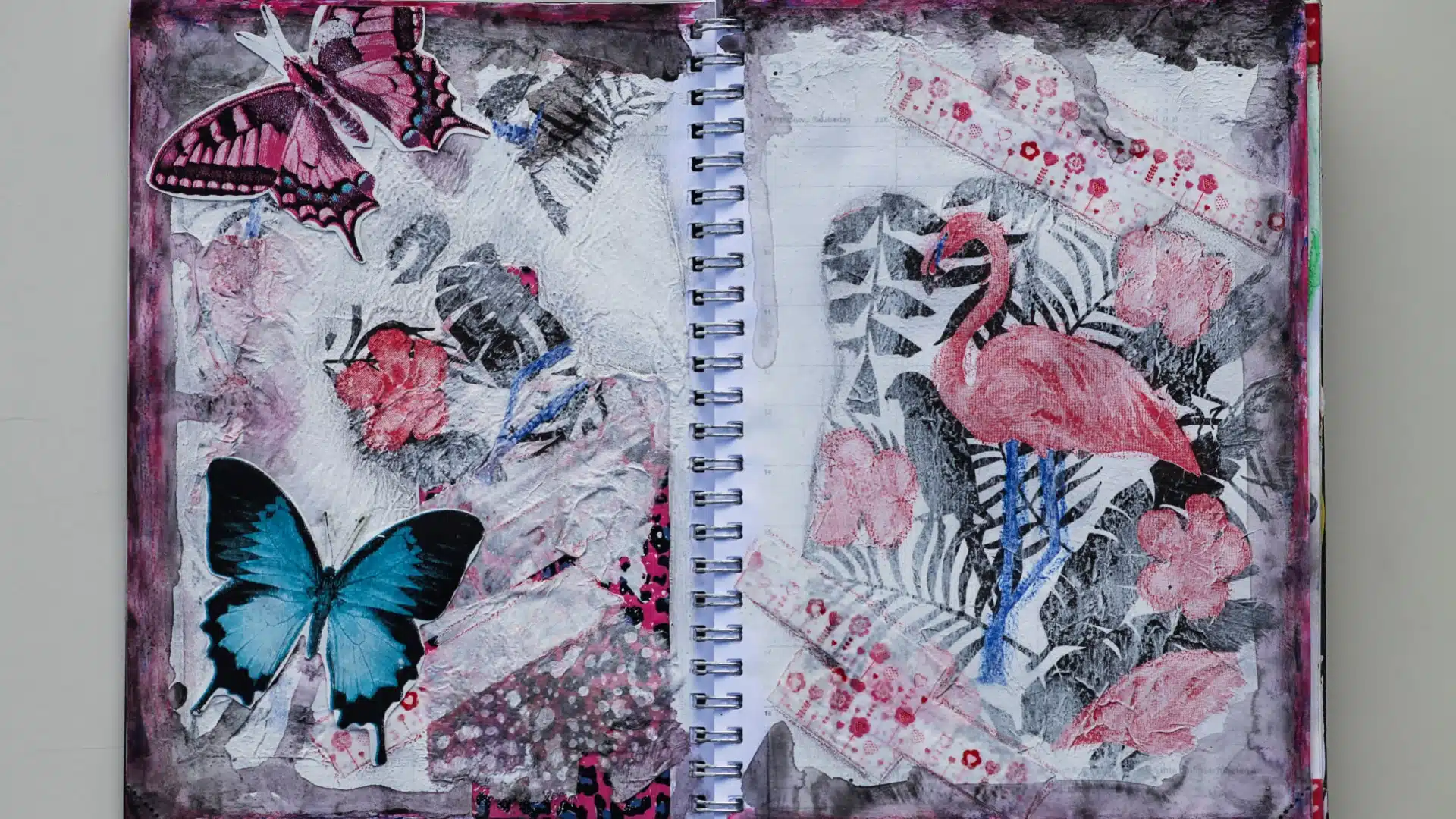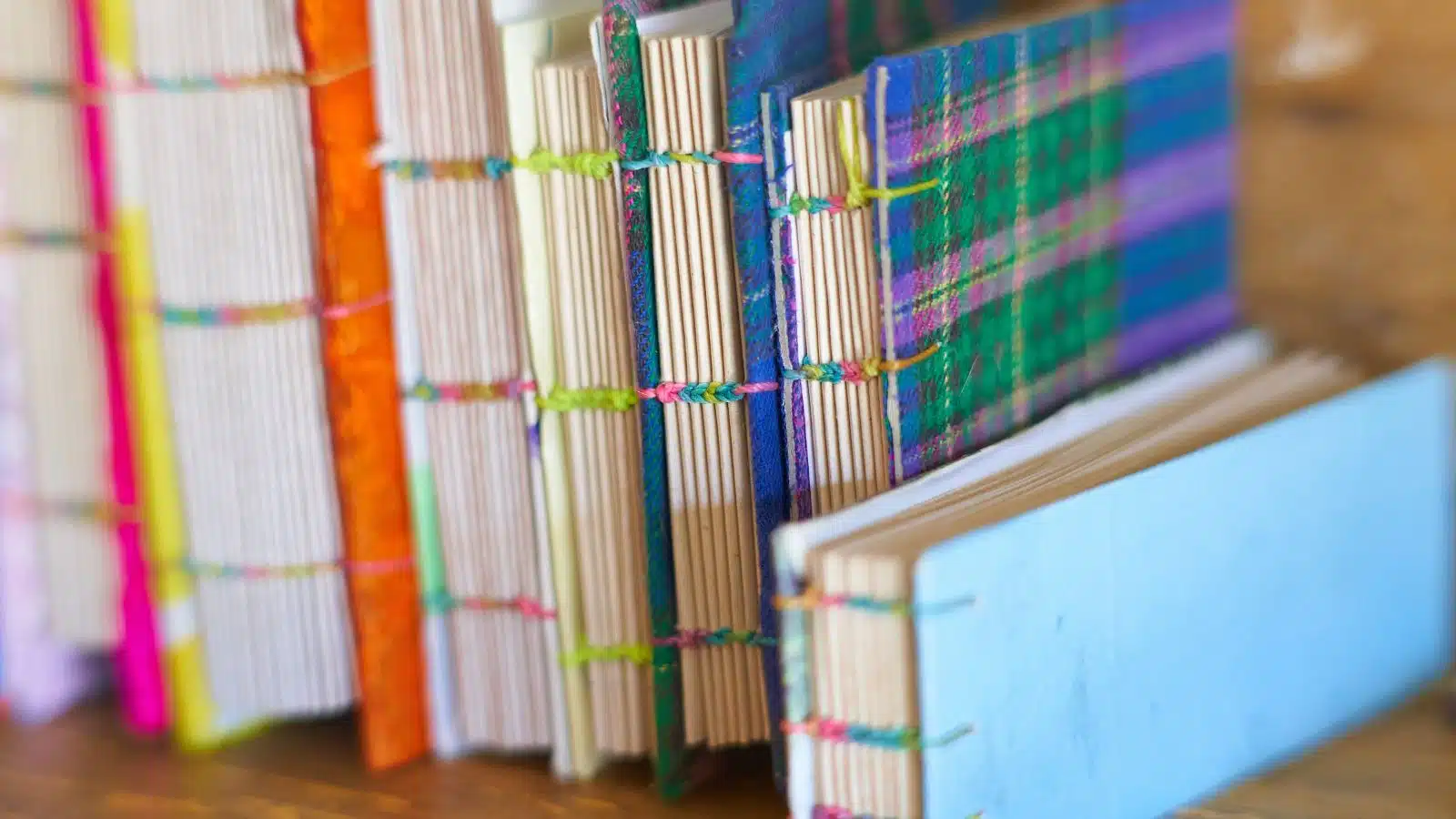I love the creative aspects of journaling.
My favorite thing about the hobby is how personal and unique the experience can be. Everyone has a different reason for journal writing, from boosting productivity with a bullet journal to enhancing creativity with an art journal.
The most unique journaling experience combines creativity with recycling. If you haven’t tried it yet, consider making a junk journal.
What is a Junk Journal?

A junk journal is a handmade journal you craft using materials found around the house.
Though traditionally, junk journals are made with scraps and unneeded papers, you can tweak the rules to create a journal that genuinely suits you. Some people prefer a more vintage look, so they use tea bags to color the pages, while others look for vintage paper to make their pages.
Why is it Called a Junk Journal?
It’s called a junk journal because it’s made from junk.
Don’t let the name deter you. Creating something functional and beautiful from what is traditionally considered trash is a wonderful way to reduce waste. Junk journals can become works of art in their own right.
What’s the Difference Between Junk Journaling and Scrapbooking?

People use similar materials, like scraps, ephemera, and other memorabilia, in junk journaling and scrapbooking.
The two hobbies have a lot of similarities, but there are a few key differences. The most significant is that in scrapbooking, the entire point is preserving these treasured pieces of your own history. A scrapbook is a walk down memory lane, with memories, photos, highlights, tickets, and more organized in a fun way to spark happy memories.
Although a junk journal can use many of the same items, the intention is different. You’re not safeguarding memories, you’re using an old receipt as a page so you can write on it. You don’t care what the receipt was for.
However, many people combine scrapbooking and junk journaling, making pages out of trash while preserving the items that are important to them.
There’s no requirement to use it that way. Once your journal is made, you can use it for whatever you want.
How Do You Use a Junk Journal?
The sky is the limit when it comes to using a junk journal. It can be a diary, art journal, notepad, task list, planner, scrapbook, keepsake, or anything else you decide.
Once it’s created, you can use it like any other journal. Write down your thoughts, feelings, hopes, and dreams. Use it as a sketchbook. Take it with you to record important events.
Although there is no right or wrong way to use this type of journal, three journaling styles work well with junk journals.
Using Your Junk Journal as an Art Journal

Art journaling is an ideal way to use a junk journal. Draw, sketch, paint, and design things on your journal pages.
It’s essential to consider the composition of your junk journal if you plan to use it for art. When making it, use sturdier paper that can handle any paint you will use.
If you dabble in various arts, mix up the type of paper on the pages. Include watercolor paper, canvas, and mixed media papers so you have the right kind of paper for whatever media inspires you on a specific day. Add blank pages that you can fill with sketches.
The ability to craft a journal based on what you want is the best part of creating a junk journal. You can design something to fit your personal artistic needs.
Junk Journaling for Creativity
Making a junk journal enhances the creative process. Seeing pages filled with unique textures, colors, and designs offers inspiration for even more creativity.
The process starts before you use the journal, during the crafting process. You get to combine interesting scraps to make pages for stories, poems, or creative writing. Once the pages are done, you can use them as inspiration for your writing in a continuous cycle of creative activity.
A bonus is that the odd-looking pages provide permission to craft a story without worrying about proper form and function. It can be as messy as the pages.
If you are using your junk journal for creative writing, ensure you have some blank pages to work with. These pages should have light colors to make the writing easy to see. You can make blank pages with old envelopes, receipts, or scraps of sticky notes you didn’t use.
Of course, you don’t have to leave all the pages blank. Include your own journal prompts to explore later, split the pages between printed content and blank space for writing.
Break pages up with decorative scraps around the edges and blank space for writing in the center, or dedicate half to poems and half to decorative stickers.
Let your imagination guide you in designing your perfect journal pages.
Making a Diary out of a Junk Journal
One of the best ways to use a junk journal is as a simple diary. Use it to record your thoughts, feelings, and desires.
Junk journals turned into diaries are perfect for creating a scrapbook/diary hybrid. Make your journal half scrapbook pages and half journal entries. Add handwritten notes to the movie tickets, receipts, wristbands, and convention passes you used to create your journal pages.
The best thing about turning a junk journal into a diary is that you get to create a book that is 100% and unapologetically you.
How Do I Make a Junk Journal?

Part of the fun of junk journaling is making the journal. Here are some tips to help you craft the perfect junk journal for your needs.
1. Know Its Purpose
Knowing what you want to use your journal for is the first step to crafting the perfect journal. As you saw above, art journals need technical paper to handle mixed media, whereas a diary might need more blank pages.
Think about what you want out of your journal, then decide what you need.
2. Gather Supplies
Next, you need to get your supplies together. Here are some common things you may need to craft your journal:
- Cardboard: Cardboard is one of the best materials to use for the front and back covers
- Linen: Use old fabric or linen to make a soft cover for your journal
- Pages: Collect scraps to form the pages. Items could include notebook paper, receipts, flyers, tickets, envelopes, canvas, Post-it notes, and any other random scrap paper you may have lying around. Keep your intended use in mind when gathering materials to ensure the things you use will work for your intended purpose.
- Thread: for binding your journal
- Decorations: You may want to include stickers, glitter, beads, seashells, or other embellishments in your journal. Decorative elements can also be added later.
The supplies will go into making your journal, but you need additional equipment to build it correctly. You may or may not need all of these things, depending on how you decide to build your journal.
- Scissors
- Ruler
- Glue stick
- Stapler
- Three-ring hole punch
- Tape
- Binder clips
3. Create Your Pages
Now that you have all of your supplies and materials, you can create your pages. There are many ways to go about this, and you will probably use every possible combination to craft unique pages while making your journal.
Use your scissors and ruler to cut scrap paper into the perfect size. Glue and staple items together, however you see fit.
Decorate the edges with doodles, stickers, or ephemera. Use different-sized paper to create pop-ups, add envelopes to incorporate hidden messages, and let your imagination take over in designing pages that best suit your journaling needs.
Keep in mind your primary reason for journaling when designing your pages to keep room for sketches, diary entries, poems, or the things you need.
4. Make Your Cover
Now that you have your pages ready, you need to make your covers. Although you can use regular paper as a cover, cardboard provides a sturdier journal. You can use something like plywood for an even harder journal cover, but that will be harder to bind into a book.
Grab your cardboard and cut it into the correct size. Consider the front, back, and middle when cutting your cardboard. Your piece should be big enough to properly fold into all three components.
Next, cover your cardboard with linen or canvas. Tightly covering the cardboard and stapling it is a quick and easy way to ensure it stays stable, but you can also sew it or try gluing the edges.
5. Bind your Journal
Finally, you need to bind your journal. Some folks put their pages into a three-ring binder to skip the bookbinding, but crafting your own is part of the fun.
There are many ways to bind your journal together. You can use a needle and thread or hole-punch the pages and use a thicker material, like twine or leather.
First, line your pages and covers together. You can use binder clips to keep them secure. Once the pages are securely together, you can start threading.
Binding your journal with a needle and thread is a tedious process. You will need to use a thick needle and thread to pierce cardboard and have stitches close enough that the journal won’t fall apart. Tightly stitched pages will result in a more sturdily bound journal.
Another option is threading a thicker material through pre-made holes in the paper and covers. Use a hole puncher to create your holes and bind the papers with elastic, twine, or even leather. This method is a little easier but will result in a looser journal.
Can I Buy a Junk Journal?
Hey folks! Transparency Disclosure- Some of the links in this article are affiliate links. That means I’ll receive a small commission if you decide to click on it and buy something. Don’t worry, it doesn’t cost you anything extra!
If making your own junk journal seems overwhelming, never fear! You can purchase a junk journal on Etsy. Sellers on Etsy offer everything from complete bound journals to vintage papers to junk journal kits.
The advantages of purchasing a junk journal are that you support independent artisans and creators, and you get a journal you don’t have to make yourself.
The disadvantage is that it’s someone else’s craft project. A handmade journal you create yourself will be more memorable than something you purchase.
Junk Journaling Supplies
Now that you have your perfect art journal, it’s time to put it to use! The supplies you need depend on how you will use your journal. If it is a diary or planner for your creative pursuits, you may only need pens and pencils.
However, suppose it will be an art journal. In that case, you will need various art supplies, which may include pastels, watercolors, brushes, colored pencils, or anything else you need for mixed media art.
You can get all of your junk journaling needs at a craft store like Blick Art Materials.
Ready to Get Crafty with your Journal?
Making junk journals is a wonderful way to get use out of your craft projects. You get to make the journal itself, but you also get to use it for other creative endeavors. It’s a two-for-one!
The best part about junk journals is that there’s no limit to how you can make them or what you can do with them once they’re finished. It’s your personal creation, so anything goes!
If you’re ready to get creative and attempt a hobby that keeps on giving, give junk journaling a try. Of course, if you don’t enjoy it, you can always return to your trusty Moleskine journal.


